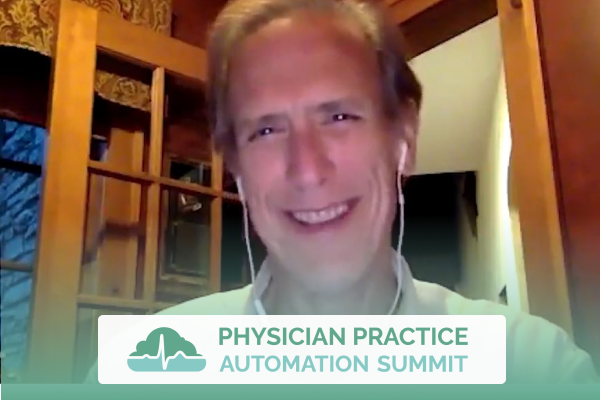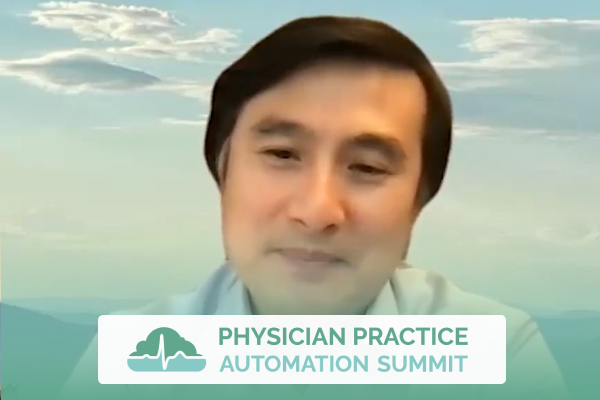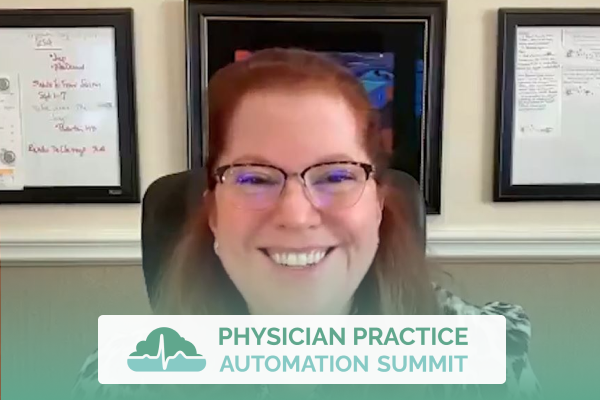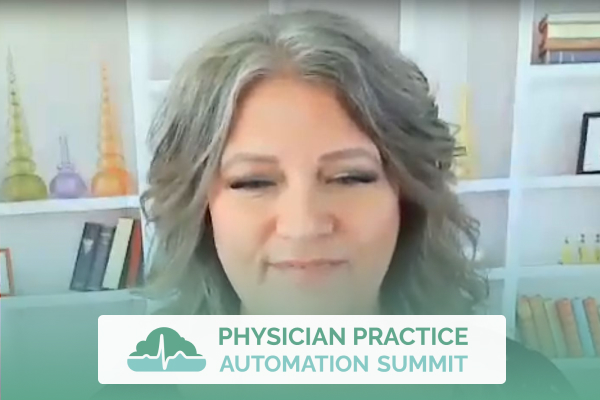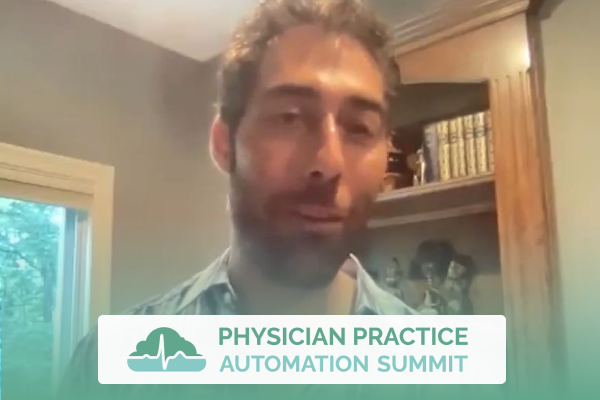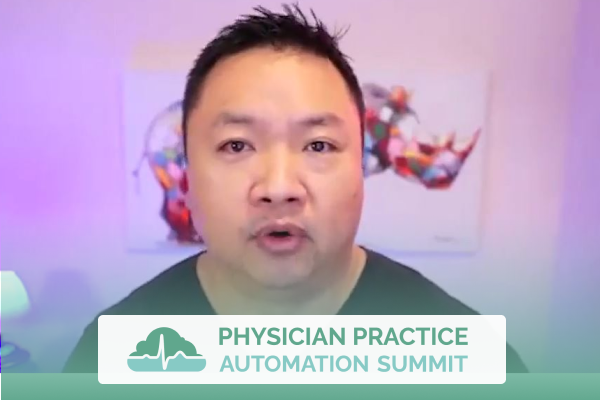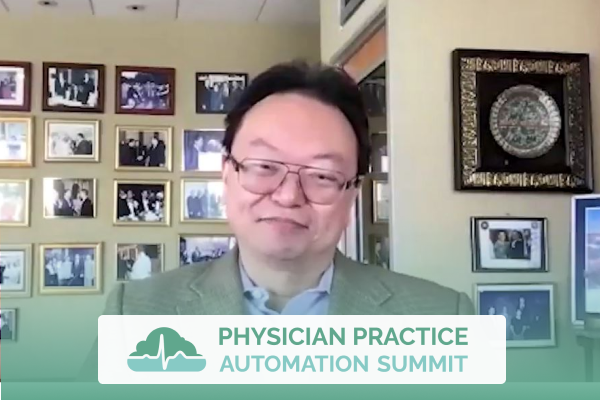Join the discussion below
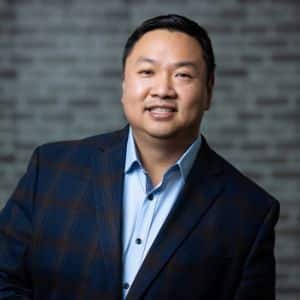
Dr. Ruan is the Founder and CEO of Texas Center for Lifestyle Medicine. He devotes his career in practicing and building systems that allow for efficient delivery of healthcare. He is a board certified internal medicine physician but also have advised with companies to improve their workflow, company culture, marketing,... Read More

Dr. James Fricton is a Professor Emeritus at the University of Minnesota in the Schools of Dentistry, Medicine, and Public Health and Senior Research Investigator for HealthPartners Institute. He has 35 years of full-time experience in clinical care, research, and teaching in with a focus on the field of chronic... Read More
Cheng-Huai Ruan, M.D.
So wonderful to have Dr. James Fricton on today. He’s a professor at the University of Minnesota, the School of Dentistry. And my gosh, I think that what we’re about to go through has blown my mind and I hope it blows yours because talk about an industry leading innovative technique, addressing chronic pain, but truly, truly getting to the root and not just talking about medications and stuff like that. So, Dr. Fricton’s got 35 years of full-time experience in healthcare and research and teaching with the focus on the field of chronic pain. And he’s developed something called PACT, which we’re gonna get into a little bit later on. And I think this is something that’s truly gonna change the world, and this is why I wanted him to be on our digital summit. So Jim, great having you here.
James Fricton, DDS
Thank you very much, Cheng. It’s a pleasure to be here and to share with some of my experiences over the years of working with chronic pain patients. Actually since about 1978.
Cheng-Huai Ruan, M.D.
Oh wow, wow.
James Fricton, DDS
When I started.
Cheng-Huai Ruan, M.D.
Obviously you’ve been doing this for a while, but let’s talk about some pain points here for a lot of doctors. So it doesn’t matter what specialty lot a doctor’s in, it doesn’t matter if it’s primary care or orthopedics, dermatology, rheumatology, whichever one it is. Taking care of patients in chronic pain requires a lot from the doctors, from the staff, from the family members and communication, and it just requires a lot. And I feel like those people with chronic pain are kind of brushed off. You see this in the emergency room. Right?
James Fricton, DDS
Right.
Cheng-Huai Ruan, M.D.
See this in inpatient, even. The only place I feel like a chronic pain patient is welcome is in hospice. It’s like the only place where it’s like welcome. Welcome in, right? And so let’s try to change that for a bit, but let’s kinda categorize. Can you categorize some of these patients with chronic pain? Like what kind of patients are they and how should we do anything about it?
James Fricton, DDS
Well, it’s very interesting. The whole sort of population with chronic pain. The youngest patient I had was about five years old. Chronic headaches, neck pain.
Cheng-Huai Ruan, M.D.
That’s so sad.
James Fricton, DDS
Jaw pain. The oldest one has been 96. So chronic pain has a potential impact for any age group within the population. And, of course, I do have patients who are probably more above the age of 60 or so, but that doesn’t mean that all people cannot develop a pain condition that it persists. Now, one of the interesting studies or multiple studies that I found was, well, when a person has an acute injury, what’s the percentage of patients have pain that persists and lasts beyond five years? Take a guess.
Cheng-Huai Ruan, M.D.
I don’t know, 50?
James Fricton, DDS
Yes, 50%.
Cheng-Huai Ruan, M.D.
Okay.
James Fricton, DDS
So that means when you have acute pain that lasts at least a month, at least within our current health care system, it will last beyond five years. Now, there’s reasons for that. And that’s what we have to figure them out.
Cheng-Huai Ruan, M.D.
I feel like whenever we just talk about pain in general, it’s really not just about this subjective feeling of pain. There’s so many things that come with it, like the socioeconomic status, the social determinants of health, their financial situation and stuff like that. And I just don’t think it’s what we were trained to deal with. Or we were trained, we weren’t trained to deal with it in the appropriate way. How do you have a system where it’s more like patient centered when you’re dealing with chronic pain patients?
James Fricton, DDS
Well, it’s a challenge in our current healthcare system because we don’t have time. I mean, how do you evaluate a whole person or all their aspects of their sort of risk factors that drive chronic pain? How do you evaluate them, identify them. And then, of course, address them in the context of your treatment program. And within our current healthcare system, it doesn’t really allow for the time to do that. And so we have to develop other tools for which to do that. And it’s critical to really identify those patient centered factors that drive chronic pain.
So what I’d spent the last 10 years doing is really researching the literature to identify, well, what are the factors that drive acute-to-chronic pain and are they risk factors or are they sort of a lower number of protective actions that you do, and how do they contribute to it? How do they categorize, and that’s one of the areas that I’ve studied very carefully and developed a course for patients, for providers at the University of Minnesota, it’s called Preventing Chronic Pain. A human systems approach to kind of present that. And it’s a part of a course called coursera.org. It’s a free course and it helps kind of sort out all of those risk factors. But then, of course, when you know what they are being practical about identifying them and implementing something to help support the patient and change them is the complicated factor.
Cheng-Huai Ruan, M.D.
Well, it’s also gotta work in business too, right? Because from a primary care standpoint at least, it’s the average time a doctor spends with patients on one-on-one is about seven and a half minutes, right? And so, we laugh at that, but unfortunately that is the median time. And believe it or not, it’s about 13 minutes on documentation per seven minutes of spending time with the patients. So that’s a big issue. So I think that before electronic medical records, written documentation is relatively easy and you get to spend a lot of time with the patient. Now, a lot of it’s kind of typing in front of the patient, unless people have a scribe, and then trying to triage someone with needs and in seven and a half minutes, not only is it impossible, I think it’s doing a big disservice to the patients in no matter what field you’re in, and so obviously we have to get some help here. Right. Obviously.
James Fricton, DDS
Hopefully.
Cheng-Huai Ruan, M.D.
Yeah. So from a primary care standpoint, and this is usually what we primary care docs do, so refer to pain management, physical therapy, occupational therapy, and maybe some chiropractic or acupuncture work if we’re into that sort of stuff. And I feel like there’s a lot of, these services, are more like done for you rather than you do the work. And in my field of integrative medicine, a lot of this is about empowerment and coaching through and everything. And so I don’t think that our medical system is necessarily set up for that coaching side, especially, if you wanna see somebody in seven and a half minutes, but even so if you do wanna see this patient for 15, 30, 60 minutes, the business model has to be there. And so the whole reason I’m talking about this is because we’re missing something and I think that’s health coaches because that’s really what you develop. So can you sort of walk us through what do you have in mind, like this master plan, is your solution for this chronic pain issue?
James Fricton, DDS
Well, that’s a very good question and very good discussion too because primary care is where it begins. I mean, somebody has an acute injury. They go to primary care first. Back pain, neck pain, headaches, jaw pain. And an interesting study at Mayo Clinic found that 2/3 of all visits of all patients that go to primary care are related to pain conditions. So that is really their majority of their practice. And when you spend five to 10 minutes with them, it’s hard to identify anything beyond just physical diagnosis. Now, 100% of my patients have a physical condition that’s causing their pain.
Most of the time it’s called myofascial pain. It’s a muscle related pain and complicated by joint problems like arthritis or disk disorders. And so when they have those conditions that’s what’s focused on, and usually it’s so easy to write a script and that leads to the opioid crisis, multiple medications. I’ve seen, most of my patients or many of my patients, have at least 10 to 20 prescriptions given to them. The average number of years that a patient has pain prior to seeing me is about five. And, of course, prescriptions is the way to go. And then when you have five to 10 minutes, that’s a problem. So somehow we have to figure out how to transform that visit, not taking more time, but how do you really engage the patient within some type of a program that is an extension of your care that allows the patient to really understand not just the physical problem, but also those lifestyle or patient centered factors that are driving that, and that’s really the key.
And so we have developed a strategy for which to allow that with a simple phrase, and this is a phrase that all primary care doctors need to provide their patients and specialist also. And it’s very simple. “I’m happy to treat you.” This is what you tell patients. “However, it’s more effective long-term if we also train you to reduce the causes of your pain. Are you interested?” That does two things. It shifts the paradigm. It starts putting the responsibility to some extent on the patient to improve their condition. So that’s one thing. And that it’s training and things like that, and it’s more effective long term. And then it shifts the paradigm from the physician to the patient. And then it also opens the whole door to the patient saying, “Really? I have the ability to manage my pain?” And when they have that ability and when they have that shift in paradigm, it’s not about taking the drugs. It’s not about some passive treatments, which do help. They do help, and we don’t recommend stopping that, but we also have to implement a training program, a support program, and that’s where telehealth coaching comes in. Does that make sense?
Cheng-Huai Ruan, M.D.
Absolutely. So you said something earlier was asking the patients, we have something that you may be able to do to activate lifestyle metrics that is able to possibly reduce or control your pain. and then, the next phrase is, probably the most important one, is are you interested?
James Fricton, DDS
Right.
Cheng-Huai Ruan, M.D.
Yeah, and now the patients they’re there in the cockpit of on their own plane. They’re the one flying, like you’re not the one flying for me. And then I said this on multiple other interviews is where doctors have to be for patients now is not to play the hero role, but have the patients be their own heroes. And to do that, you have to switch from a doctor being the hero to the doctor being a guide. And I think, in our practice, when we started health coaching, we became guides and the health coaches became even bigger guides for the patient. Now there’s empowerment that really happens. I think that the structure of our vernacular is just absolutely crucial in the patient interaction. And I’ll tell you what, and I swear half the time, we get pain scores and PRO data for patients, and half the time like the patients are in less pain leaving your office because they have some level of certainty that there’s something to be done. Does that make sense?
James Fricton, DDS
Yes, yes. In fact, if you look at the randomized clinical trial. So I spent about five years doing systematic reviews of all randomized clinical trials for all pain treatments. And interestingly enough, medications, physical therapy, chiropractor, patient self-care, surgery, injections, it was really surprising the results of that. What we found essentially was that every treatment worked above and beyond placebo to some extent, usually about 10%. Some of them are longer terms. Most of them were short-term effects because that’s all you can really do on a clinical trial. So what was interesting that the nonspecific therapeutic effect of the interaction between you, the patient and the treatment, that belief system, had the biggest effect.
So it’s called the placebo effect. But we don’t like to call it that. I like to call it the non-specific therapeutic effect of a relationship of caring for somebody else. Now that has a big impact. Treatment has a big impact. But what we found to be the most effective treatment of everything was self-management, was the patient’s belief in self-efficacy of how they can control the pain themselves. And that shift in paradigm, our healthcare system doesn’t allow that to happen very often. But with that simple phrase, “I’m happy to treat you, but it’s more effective long-term if we also train you to reduce the causes of your pain, are you interested?” That simple phrase shifts the paradigm. And then, of course, they say, “Yes.” That’s what makes most doctors nervous. Oh, no, I’ve got to figure out how to train them, or at least involve them in a program to do that. And that’s what we’ve developed is a very simple transition to, well, we have a solution for you if you’re interested and willing.
Cheng-Huai Ruan, M.D.
But if they say, “No,” it’s actually on them.
James Fricton, DDS
Right.
Cheng-Huai Ruan, M.D.
We document a patient that does not want to be part of the program at this time in the documentation. Let’s follow you up in the next month. We will reach out back out to you to see if you wanna incorporate into this. And that’s something that’s really worked for our practice and other different coaching systems within our practice. But, well, let’s rewind something here ’cause my mother’s an acupuncturist. So I have to mention this. You said that most of your patients, or 100% of your patients have a pain that’s from a physical source, and most of it’s the myofascial, right?
James Fricton, DDS
Right.
Cheng-Huai Ruan, M.D.
Myofascial is probably the most common word that comes out of my mouth on a daily basis.
James Fricton, DDS
Me too!
Cheng-Huai Ruan, M.D.
Yeah. And for those of you who aren’t really trained in this, the myofascial produces the most placebo effects in clinical drug trial history. And I’ll tell you why. So there’s studies showing that those patients with end-stage lung cancer have better mortality in hospice than they do with aggressive therapy. And it’s not because chemo and radiation didn’t necessarily work, but because their threshold of pain is less, they’re myofascial muscles are a lot more relaxed. So when you translate that into other disease states and disorders, we see a lot of patients with Ehlers-Danlos syndrome, so EDS, and dysautonomia and POTS, so same thing, it’s the myofascial. But when you give them some sort of sense of certainty, like verbal sense of certainty that, “Hey, you’re probably gonna be okay, but it requires this and you’re in the driver’s seat.” And so when they take it upon themselves they become empowered, their pain scores just drop.
And so I think there’s already more power in words, then there are in prescription just off the bat, but at the same time, if you have a whole program that’s dedicated to it, like we do for a lot of the other stuff in our facility, it’s a home run and it gets you like five star reviews, like on Google. There’s nothing better than closing the loop on those types of patients. But guess what? The patient said, “No.” We’ll check with them again, and when they’re ready, they’ll be ready. But we’re not necessarily tied to the outcome. We’re tied to the fact that we have this for them, when you’re ready, you’re ready. And that’s the guidance mentality rather than the heroes mentality. So I truly appreciate what you’re saying here. So let’s go into the program, let’s go into the PACT Program because you shared with me a file earlier that had all this data on it. And so let’s give a shorter version of that to the audience and by starting with, well, what does PACT stand for?
James Fricton, DDS
Well, PACT stands for, that’s P-A-C-T-, personalized, activated care and training. And I’m a half researcher and half pain specialist. and I was trained in both dental school as well as the medical school pain management anesthesiology program. So I’ve got kind of this sort of blend. And then I’ve also have an advanced degree in research. And so as a professor at the University of Minnesota, I’ve had lots and lots of NIH grants to really support looking, not only at the longitudinal factors that drive chronic pain, but NIH did fund the development of a platform called the PACT Program that provides a very simple strategy for which to implement patients into a robust pain management training program with telehealth coaching. And it makes it so easy to implement that as part of your routine care. And it kind of extends my care into the patient’s life.
And the coaching aspect of it’s very critical because, again, it’s part of that nonspecific therapeutic effect of a relationship between you and the patient, and the coach and the patient. And it has a very powerful effect in helping guide the patient to achieving their goals by making the lifestyle changes that they really need to make. And so the program involves several components. There is a technology platform that’s equivalent to an electronic health record. We call it a patient engagement platform. And it’s like an EHR only it’s for the patients. EHR is just for us and for billing and things like that, a PEP, or a patient engagement platform, is really for the patient to be engaged in this comprehensive sort of strategy for which to what we call transform them or transformative care. And so what we did in the clinical trials or in the study, the longitudinal studies and the review of the literature, is try to identify all of those risk factors that drive acute-to-chronic pain in all aspects of our life. Then we developed a risk assessment based on all of those. We tested it out on 1,500 patients as part of this course on Coursera. They all took it. We looked at the correlation between that risk factor and the severity of pain and the persistence of pain.
So we validated this risk assessment. So that’s one piece of it. So what the patient does, and what the doctor does, is say if the patient’s interested, they can just simply enroll them in this platform. It takes about 30 seconds and the doctor doesn’t do. It’s usually the staff that does that or the front desk. And then the first thing they do is take a pain and risk assessment to really understand that person and the whole person, not just their physical condition and diagnosis. So there’s the risk assessment component, then there’s risk reduction training program. So for every risk factor, there’s a brief five to 10 minute micro lesson on, okay, here’s the problem. Here’s why it’s a problem. Like, say for instance, something simple as clenching your teeth or tensing your shoulders, or sitting at a computer all day long or stressors or anxiety, I mean all aspects of life. And I’ll go into that in a second on all the different areas of pain, but that training then provides them some really quick lessons ’cause nobody wants to spend a half hour on the computer listening to it.
They really wanna get to the information. So these are micro learning, micro lessons. Then based on that risk assessment, the coach, there’s the third part of the program, is the coaching. And so they schedule that first visit with the coach and the coach provides orientation on trying to understand why there are patient centered factors that play a role in these pain cycles that perpetuate pain over time. And so it helps to clarify what they need to do and helps them set their goals. It’s not just always about reducing their pain, but it’s about reducing the impact that the pain has on their life is actually more important. If they can’t work or they’re not able to take care of their families like they wanna do, or they can’t go out for a walk. It just hurts too much. That impact and their coping skills, is also critically important.
So it helps them set the goals, the broad goals, and then guide them and support them in achieving those goals. So those three parts, risk assessment, risk reduction training, telehealth coaching, all occurs outside of the doctor’s office. And it’s then the doctor will see the patient another month, they’ve already gone through a couple of coaching sessions, some lessons, they ask them about how are you doing in your self-care? And the patient talks about it. Usually they rave about their health coach because everybody loves health coaches, health and wellness coaches, and it’s not about reversing the negative.
It’s about implementing protective actions. So healthy habits and calming practices and developing mindful pauses throughout the day so you just simply pay attention to what you’re doing. It’s about implementing really positive protective actions versus reducing risk factors because that naturally happens when you implement healthy habits every day. So those three things are put into a program. We called the PACT Program. Very simple, easy to implement, but then the patient is engaged in something outside of the clinic that really helps transform their lives. And we call this model where you do training with treatment using technology and telehealth coaching, all Ts, as transformative care, it starts with T also. So it’s kind of a acronym.
Cheng-Huai Ruan, M.D.
So, in your more than three decades of experience with pain, how do you see this impact America? Like, just tell me what your vision is for this person.
James Fricton, DDS
Well, it kind of goes back to your original discussion and point about the business model. Obviously, the business model drives practice to some extent. So we collaborated with the health plans, Blue Cross Blue Shield, United Healthcare, Aetna, all the large health plans in Minnesota, as well as nationally to really say, okay, we have a model of transformative care that we really believe strongly if you want to stop the opioid crisis and really reduce chronic pain. Chronic pain patients cost 20 to $40,000 per year to the health plans and to employers. I mean, they’re the big elephant in the room of healthcare. So getting back to the business model then is how do we get reimbursed for implementing this program? And we tried a variety of different CPT codes, and they didn’t get reimbursed because they were generally provided by mid-level providers and reimbursed at a relatively low level. And it wasn’t really cost effective and physicians could not implement this.
So we went to a model where one of the CPT codes that we found works really well and was recommended by the health plans to use was 99409. Now that is a little bit of an unusual code because it’s about substance misuse. And so preventing substance misuse, but preventing chronic pain. So we broadened that concept so that 99409 could be reimbursed. And so the platform is designed to, when the coach has a visit or there’s a risk assessment, that a billing sort of form is set up, it’s a PDF form. And the billing team for that clinic then can just simply download it every week and add that to the providers sort of services that they provided, and it gets billed to the insurance company. So that business model, which is relatively simple, and the billing staff seemed to do it quite well, and it adds revenue to that primary care or specialty provider. And so we have found that we’re able to generate a net revenue for the provider to implement transformative care.
So, you can do blocks and injections and things like that, and that adds revenue, and it does help patients for sure, but if you also add a transformative care, the PACT Program into that, it generates additional net revenue, and it supports the little bit of additional time that is provided by the health professional. So we believe that that model, when it’s a triple win, so the patients benefit ’cause they get better, the health professionals benefit because it extends their care and the patient’s life, and they get reimbursed and a positive net revenue. And the third thing is really important. Since pain patients cost 20 to 40,000 per year because if they get ongoing treatments, we have found that this decreases healthcare utilization considerably and improves and reduces healthcare costs considerably. So we believe that triple win. It’s health professionals, health plans, and, particularly, the patient will drive use of this. And we’re just at the beginning stages in the first year. But it’s an interesting, when you brought up the business model, I think it’s important to recognize that.
Cheng-Huai Ruan, M.D.
Absolutely, you can’t do anything without the business model. You can’t scale anything without the business model and something like this that truly caters towards the patients decreases costs overall of healthcare expenditure. I mean, the payers got to see this as a win. So I’m glad, the Blue Cross Blue Shield, whoever it is, recommended you using these CPT codes. But now I think we’re, hey, we’re in 2021. So 2021, lots of CPT changes came out. 2022 even more ’cause they released those in July. So I had a chance to take a look at them. So now we’re also in, a lot of physicians, are in digital health as well. And we also have the opportunity of being reimbursed for digital communications.
So whether it’s email messaging, secure messaging, text messaging, phone calls, checking phone calls, CMS has has brand new CPT codes for this. And so I think there’s a way where we can improve the more touch points for the chronic pain patients through not just the substance abuse counseling or screening code, but also all these different things sort of engaged together to formulate a very cool and structured way to deal with chronic pain. It’s actually very similar how we deal with other chronic conditions as well, not just chronic pain. But most chronic conditions have some pain associated with it. So it’s pretty all encompassing. So I think that if we, if I understand this, then this is is really, these visits, these assessments and the touch points, are really taken on a digital platform outside of the doctor’s office. And so what do you think are, are there any negative impacts to the workflow of a doctor’s office at this point?
James Fricton, DDS
Well, one of the questions that always comes up by patients that’s really important is, “Is this reimbursed?”
Cheng-Huai Ruan, M.D.
“Yeah, does my insurance cover it.” Yeah, all the time, yeah.
James Fricton, DDS
Exactly. And so one of the issues that we have frequently is that when we bill it out, we bill out the coaching, we bill out the risk assessment and that’s usually done on a monthly basis and it’s billed under the provider’s name, and it lists it as sort of preventing substance misuse. And so one of the red flags that come up is “I don’t have a substance problem. I’m not an alcoholic.” And is this going to get on my record that I’m doing this? And so.
Cheng-Huai Ruan, M.D.
Yeah, I can see that.
James Fricton, DDS
Yes, it brings up questions. And so what we do at the initial consent form within this is explain that to them and explain that this is not a red flag for you. It’s not going to necessarily make people think that you have a substance misuse problem. So part of that is just the upfront consenting form that the staff typically does when they enroll them in the program. And the vast majority of patients really don’t have any problems with that. But there are some patients who do have substance abuse problems, and so we really work with them. That’s one of the major lessons. And one of the criteria for billing that 999409 is to use a risk assessment that identifies whether or not there are any substance misuse or substance concerns at all.
So it’s all part of that initial assessment form to really help us identify. The other issue that comes up sometimes in terms of a red flag, is that some providers really have a hard time shifting that paradigm because, for instance, their revenue is generated by injections, blocks, interventions, things like that. But we’ve been able to, because there’s a net revenue, we’ve been very successful in integrating this program with treatments such as nerve blocks and injections, interventions, even surgery, when surgery is needed because it does improve the outcome of surgery. And that’s what most surgeons want to make sure they do is we wanna have these treatments have not only a short-term effect, but a long long-term effect. And let me tell you a story about a patient that I saw a couple of years ago.
He was 81 years old, and he was a CEO of one of the major corporations, and then he retired when he was 65, and I was treating his wife and his daughter, and he happened to be in the room at the same time. And they were doing so well with lifestyle changes and some of the treatments that we provided. So he came up to me afterwards. He says, “I wonder if you could help me.” He’s 81. “I’ve had headaches, neck pain, shoulder pain, jaw pain for the past 65 years every day.” Every day since he was aged 16. He says, “I don’t know if you can do anything about it. Nobody has ever been able to help me.” So of course, I said, “Well, we have a very comprehensive program and yes, if we can reduce the causes of your pain, it’s gonna improve. And some of the treatments will help too. So let’s do that.” So I worked with him for about two months or so, and he had dramatic improvement ’cause he was tensing his shoulders, clenching his teeth, really doing a lot of factors that drove, drinking lots of caffeine, wasn’t sleeping very well.
There’s just a number of factors, that he reduced his headaches and pain from every day to about once every two weeks. And when he came in, it was interesting. After those two months and he’s better, he was so angry. And I said, “Well, why are you so angry? You should be delighted.” He says, “You know, why hasn’t the healthcare system or somebody in healthcare taught me these things when I was 20 years ago or 10 years ago or 30 years ago.” And that’s a story that just sort of hits home that how important these factors are and patients really engage in it. And doctors need to know that it will improve their outcomes dramatically by integrating patient centered transformative care as part of their treatment plan just routinely.
Cheng-Huai Ruan, M.D.
Yeah, you’re absolutely right, especially with a lot of the interventionalists kind of listening to this. PRO data, or patient reported outcome data, is absolutely crucial to obtain. You want to be able to make sure you’re doing the right things, but when you’re able to accelerate on the improvements of your patients, your outcome data’s gonna go drastically high, you’re going to get better reviews on social media or on Google, you’re going to have much less perception of burnouts in your practice. And knowing that, I mean, think about how many people you can truly help in a shorter amount of time. And even without doing anything different, each phone call that comes in to your office is gonna also shift. It’s not gonna be a lot of people who are in chronic pain and upset. It’s gonna shift to a lot less of that, more people who are empowered. And I’ve seen this transform, even within my own practice and just because of the delivery of the value that we have, the coaching and stuff like that. And it makes such an impactful journey for the patients, for yourself and even for your staff as well.
So much so that you think and talk about your patient that says he’s pissed that no one told him this decades ago. But we get that every day, why has no one has really told me about this or understood about this. And so, why do you think that this exists currently? Because we talked about the social determinants of health. We talked about how each private care visits is seven and a half minutes, we already covered all that stuff. We talked about how there’s decreased engagement because of insurance reimbursement practices, stuff like that. And then we talked about just really the expectations of a patient and the value that a doctor traditionally has brought to a patient has been the power of a pen or a prescription, right? But what else do you think is causing this trend and what paradigm shift within medicine itself needs to switch so that this doesn’t continue anymore?
James Fricton, DDS
Well, I think that, of course, the biomedical model has been very successful for acute problems and for cancer and very serious problems. But what we’re seeing is an epidemic of chronic illness within our country. And I think that the model called the chronic illness care model is a model that has been promoted for the last 20, 30 years, but difficult to implement as part of routine care. And so I don’t really, I think that all health professionals generally are very sincere, caring. They really want the patients to get better. And so we want to measure those outcomes and we do that as part of the PACT Program also. So every month the patient fills out kind of a progress assessment to see how they’re doing. And then you can look at the dashboard and you can see how the pain is improving or staying the same. So you can identify red flags or other problems. And, of course, the health coach tracks all this stuff too.
So provider has access, and so does the health coach. And so I think the biomedical model, there’s a lot of pressure to shift the paradigm to a broader model that’s a whole person, and we understand that there are social determinants of health, there are emotional determinants of health, there are behavioral determinants of health, there’s cognitive, environmental. Like, for instance, environmental factors are the number one initiating onset factor for pain conditions; car accidents or other types of accidents. In our studies we’ve done and others have shown that almost 40% of patients begin their chronic pain problem with some type of accident. And so I think that there is a shift towards more transformative care. And as long as the health plans get on board and are willing to reimburse it so that there is a net revenue for the providers, what you’re gonna see is a gradual transition to a broader transformative care model, where you do treatments and training using technology and telehealth coaching.
And that model, I think, is something that is primary care, specialty care, like we have a group of orthopedic surgeons who are very interested in using this model. Pain specialists, chiropractors, physical therapists, it’s a model that really is very easy to adopt, easy to implement and to be generally reimbursed for. And so we’re hoping, we’re at this point right now where we want to provide more national implementation and that’s, of course, why it’s a pleasure to work with you today and to have this conversation is because we think it’s a model that really everybody’s looking for, and it’s just a matter of making it so that it’s, one, easy to implement, and secondly, it’s reimbursed. And patients adopt it and are interested in it. My patients, we had in our clinical trials, we did a randomized clinical trial of it. And we’ve done a case series of 500 patients in it. And the vast majority, 90% of the patients say, “Yes, I’m interested.”
Cheng-Huai Ruan, M.D.
Wow, why do you think it’s 90%? It seems to be unnaturally high for a patient buy in. Why do you think it’s that high? Is it the delivery of the value or what is it?
James Fricton, DDS
It is. When you explain it, sit down, in two minutes to explain the pain cycle, that here’s the physical condition you have. Myofascial pain or arthritis or disk problems or neuropathic pain or neurovascular pain. So here’s your physical condition and that’s causing these symptoms, but what is causing those physical symptoms to continue like that? And then I say, it’s the strain on the tissues, whether it’s clenching or tensing or repetitive strain or posture that really causes the tissues to have peripheral sensitization. And then what causes that more are the stressors within your life. And that’s from physical stressors, emotional stressors, social stressors, environmental, they contribute to more strain.
They contribute to physical sensitization, which contributes to more symptoms. And then you get into the pain cycle and it just continues. And the vast majority of patients say, “Oh, that’s me.” And I have a little diagram that I showed them then and it takes two minutes to kind of describe it. And then they say, “That’s me.” And I say, “Well, you know, we’re happy to. These are things under your control, these stressors and strains. We can’t change that for you, but we can train you to do it. We’re gonna treat this condition and it’s gonna provide you some relief.” And they love that. “But then for long-term success, you really have to learn what you need to do.” So explaining it like I just did in two minutes to you doesn’t take much time. Patients are totally engaged and they say, “Yes.” Well, then they ask the question, “Is this reimbursed?” And then I say, “Yes, in general, it is.”
Cheng-Huai Ruan, M.D.
Yeah, so, I mean, that’s the power. I think it’s all in the delivery, right? So you know you have so much buy in because I think you establish intention. Like I want you to do well. You establish education mean that here’s something that you might not know, but I think is beneficial for you. The third, and most important point, is that there’s something we can do about it. And here it is and it’s all organized into this little box right here, right? Is whether or not you wanna really open this gift box or not at this point. And put them into that position where they’re the ones taking the box and opening it. And I think that’s true with most patient care, especially in chronic pain, because these people are living in daily doubt, they’re hiding their symptoms. They’re ashamed of their symptoms. They’re ashamed of themselves.
They don’t wanna tell people about it. So they’re not used to opening up about it. And the minute that you establish a connection, they show some vulnerability, it’s natural that they’re guarded, but the minute that you give them the fact that, hey, this is within your hands and then they take it within their hands, all of a sudden that vulnerability just becomes empowerment. And I think that’s the most powerful thing we can experience as doctors in general, you know? And so that’s really what makes me get up every morning.
James Fricton, DDS
Well, and I have another case that’s an interesting case, similar to the 81-year-old gentleman, and this was a seven-year-old girl. And she was there with her parents, her mother, and she had headaches right here. She had headaches back here, and this is seven years old and you rarely do get headaches. And so, of course, we ran through all the neurologic tests and diagnostic testing to rule out anything serious. And it was that these muscles were tender, everything was tender back here. So I asked her a simple question. I said, “Do you ever find yourself touching your teeth during the day?” And she steps back. And she said, “Yeah, I do that all the time. Aren’t I supposed to?” She thought clenching your teeth all the time and tensing these muscles in the neck is something that she should just do. So I said, “No, that’s not. That drives your headaches right now.” And so she says, “Oh my gosh. I mean, that’s all I need to do?” So I saw her one time a month later, all her headaches, neck pain, jaw pain was gone just with one conversation with her.
Cheng-Huai Ruan, M.D.
When she’s seven. She’s seven years old?
James Fricton, DDS
Yeah, seven years of age.
Cheng-Huai Ruan, M.D.
Wow.
James Fricton, DDS
So it can happen to all ages, and it’s so impactful when patients understand and realize, and then grasp that oh my gosh I’m doing these things every day. And sometimes they can’t control them. Like, for instance, if they’re working on the computer all the time, shrugging their shoulders, cinching their teeth and things like that. If their work is really stressful, sometimes it’s very difficult to change it, and that’s where the coach comes in. So they help facilitate simple changes that allow them to really achieve the relief that they want long-term. That’s an interesting story.
Cheng-Huai Ruan, M.D.
That’s fascinating. My daughter’s seven, so I can kind of relate as a parent especially seeing that, and maybe as a parent saying, “Oh, here’s some, you know, Children’s Tylenol or whatever like that.” And not really getting to the root cause. And it’s an emotional thing, being a parent of a seven-year-old. And it’s an emotional thing being a son of elderly patients who are going through pain as well. And so I think that eventually it’s not just gonna be the patient buys in, it’s gonna be family buy in. It’s gonna feel really good when the other family members are really thanking you for the things that you’re truly impactful on. So this has been such a great talk, and I really wanna close it up by asking a very probing question that I never prepare any of my summit speakers for. Knowing what you know today, what is something that you wish you knew maybe when you first started practicing and figuring people out in chronic pain? What is the most valuable lesson that you know now, you can tell yourself maybe 35 years ago. Hey, this is something you should know, what is it?
James Fricton, DDS
Yeah, that is always a good question. And as you evolve in your understanding, it becomes broader, broader understanding. And I have to admit, many years ago, when I was training as a pain specialist, there was this focus just on that intervention. There was also, because it was an acupuncture clinic, which is interesting also, it’s in the Department of Anesthesiology at UCLA, I was exposed to kind of the Chinese strategy of acupuncture, which when you do acupuncture you talk to the patient about lifestyle factors, but still it was an interventionist type of clinic. And as I evolved over the years and then looked at all the research that drove acute-to-chronic pain, I wish I had known this knowledge about the broader, that 80% of a patient success is really based on what they do, 20% is what I do. And I wish I had known the clinical trials and systematic reviews, all this research on acute-to-chronic pain and risk factors. I wish I had known that, well, let’s see, 40, 40 years ago.
Cheng-Huai Ruan, M.D.
Wow, 40 years ago, that’s great. But now I think it’s time to really make an impact nationwide and bring something that’s been studied, and this is originally NIH-funded study to the masses. And it’s really time to really tackle the opioid crisis as well and increase some true positivity in a business model that’s actually scalable rather than something that is just very kind of ethereal and out there. So I want to congratulate you on helping bring impact and everything that you’ve learned over the last 40 years, to the masses. And I think that for those doctors who are listening to this, to create impact is not the same as creating a service. Creating service has done for you, which is interventions, and creating impact is the power of empowerment, which is a very different conversation. So the more operating systems within the healthcare system that creates impact and empowerment, the better the outcomes will be. And that’s truly what’s going to be absolutely changing in the pandemic era, if you will, of practicing medicine. So thank you, I’m gonna close this down. And thank you, Jim, for being on, it’s been an absolute pleasure talking to you.
James Fricton, DDS
Yes, and that’s why when you mentioned impact, that’s why the acronym PACT, which is really interesting, PACT is a pact with the patient, so it has secondary impacts also. So PACT for pain is kind of the model. So I really appreciate all the innovative work that you’re doing and really in bringing a broader model of care to all of us. So I really appreciate being on, and thank you.
Cheng-Huai Ruan, M.D.
Thank you. Thank you for watching everyone.
Downloads

